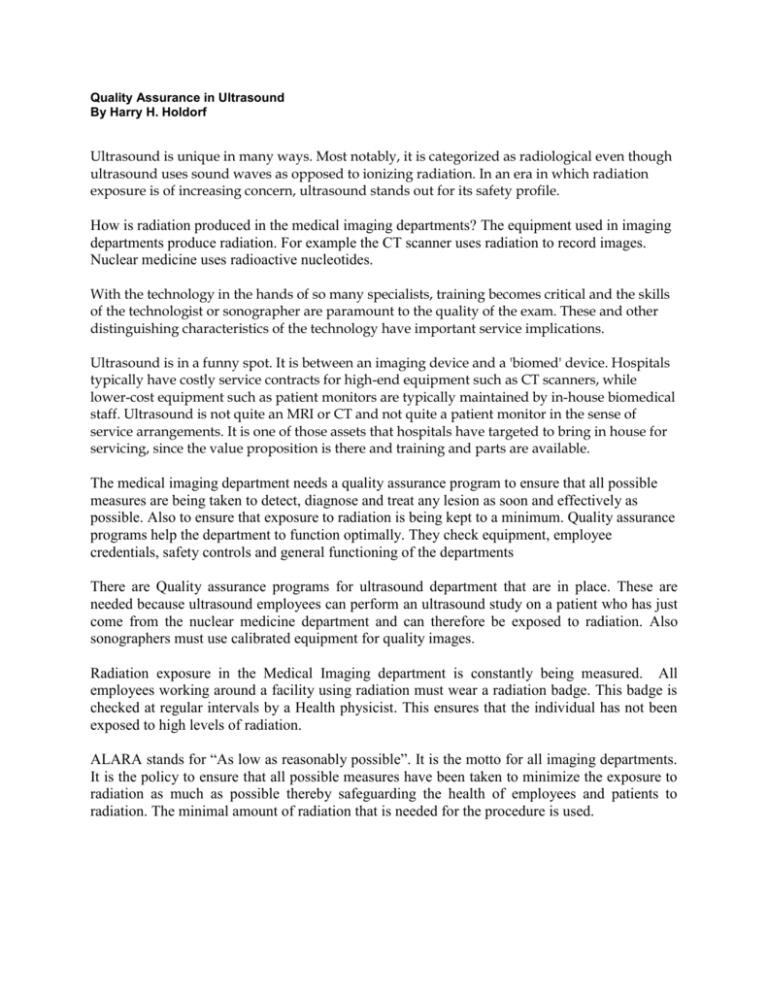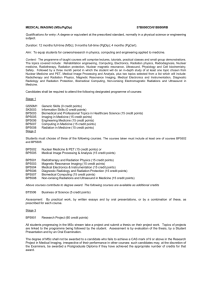Quality Assurance in Diagnostic Medical Sonograph
advertisement

Quality Assurance in Ultrasound By Harry H. Holdorf Ultrasound is unique in many ways. Most notably, it is categorized as radiological even though ultrasound uses sound waves as opposed to ionizing radiation. In an era in which radiation exposure is of increasing concern, ultrasound stands out for its safety profile. How is radiation produced in the medical imaging departments? The equipment used in imaging departments produce radiation. For example the CT scanner uses radiation to record images. Nuclear medicine uses radioactive nucleotides. With the technology in the hands of so many specialists, training becomes critical and the skills of the technologist or sonographer are paramount to the quality of the exam. These and other distinguishing characteristics of the technology have important service implications. Ultrasound is in a funny spot. It is between an imaging device and a 'biomed' device. Hospitals typically have costly service contracts for high-end equipment such as CT scanners, while lower-cost equipment such as patient monitors are typically maintained by in-house biomedical staff. Ultrasound is not quite an MRI or CT and not quite a patient monitor in the sense of service arrangements. It is one of those assets that hospitals have targeted to bring in house for servicing, since the value proposition is there and training and parts are available. The medical imaging department needs a quality assurance program to ensure that all possible measures are being taken to detect, diagnose and treat any lesion as soon and effectively as possible. Also to ensure that exposure to radiation is being kept to a minimum. Quality assurance programs help the department to function optimally. They check equipment, employee credentials, safety controls and general functioning of the departments There are Quality assurance programs for ultrasound department that are in place. These are needed because ultrasound employees can perform an ultrasound study on a patient who has just come from the nuclear medicine department and can therefore be exposed to radiation. Also sonographers must use calibrated equipment for quality images. Radiation exposure in the Medical Imaging department is constantly being measured. All employees working around a facility using radiation must wear a radiation badge. This badge is checked at regular intervals by a Health physicist. This ensures that the individual has not been exposed to high levels of radiation. ALARA stands for “As low as reasonably possible”. It is the motto for all imaging departments. It is the policy to ensure that all possible measures have been taken to minimize the exposure to radiation as much as possible thereby safeguarding the health of employees and patients to radiation. The minimal amount of radiation that is needed for the procedure is used. Industry experts report that hospitals have increasingly taken on maintenance and servicing of ultrasound equipment themselves, either through their own staff, asset managers on site, or through independent service organizations. Because most facilities have multiple ultrasound units, service issues are extremely important to healthcare providers' bottom line. You see a lot of sensitivity on the service side because many sites have 10-20 ultrasound machines; you don't just have one system, which is typical with MR or CT scanners. That is why we see providers considering lower-cost alternatives as long as the quality of service is there. Ultrasound is very interesting because unlike MR or CT, ultrasound fits very well into the core competencies of the existing biomed department. You don't need a PhD like you do to service an MR or CT. Preventive maintenance is essential but often inadequately performed. American College of Radiology standards call for two preventive actions per year along with probe testing. Here, as in most service areas, there can be huge difference in the meticulousness of providers. For instance, simple environmental conditions like linen changes and heating, ventilating, and air conditioning (HVAC) can stir up dust particles. One has to go in and monitor the system and make sure all the fan filters are running clean and free to minimize dust and dirt buildup. If you do, uptime increases exponentially. A lot of in-house biomed departments have realized this. The importance of Time, Distance and Shielding cannot be overstated. The exposure time must be kept as low as possible. Adequate distance must be kept from the patient. As you double distance from radiation force 1 unit decrease by a factor of 4. Shielding must be done for adequate protection. Lead apron, gonad shields, thyroid shields must be used as needed. Lead walls must be present in the facility. Quality assurance programs for the medical imaging department entail are quite involved. The quality assurance programs have improved the safety, quality and standards in all areas of the medical imaging departments. In MQSA (medical quality standard act) the federal government has got actively involved. All equipment is tested regularly, weekly phantom machines, processor quality control, dark room fog test, compression analysis of 25-40 pounds on the breast by the machine must be maintained and laser tests are done. Sonography Technologists and Student Sonographers students are have a slight risk for exposure to radiation. This is because in most hospitals all imaging departments are close to each other. There will be some radiation in the premises. Also the Sonographer may have to treat a patient who has just come from the Nuclear Medicine department and therefore they would be close to radiation. Also they may have to do an echocardiograph on a patient who has had some radiation. As a healthcare worker, you can be exposed to 5000mg of radiation for the whole Year. It is preferred not to get more than 10 % of this amount (i.e. 500mg/year. If you become pregnant while in working in Ultrasound, you should inform your supervisor. If possible you can be put in areas of the facility not exposed to radiation. Also you should wear a lead apron covering the abdomen and a radiation badge near the abdomen. Sonographers should wear the film badge between your collar and waist. You should immediately inform your supervisor and fill out an incident report. You should send your film badge for an emergency reading. You should use liquid soap and wash your skin and inform the safety officer. A good Quality Control (QC) or Quality Assurance (QA) program should be in place for all ultrasound departments to not only protect patients and healthcare workers, but to produce the highest quality images to assure that the department is providing the best possible patient care.








